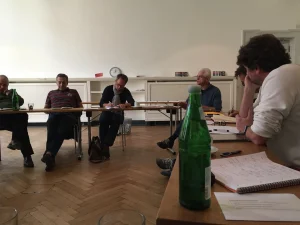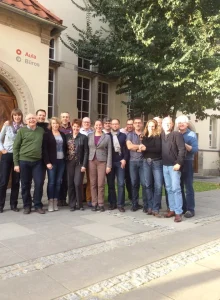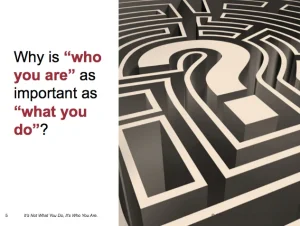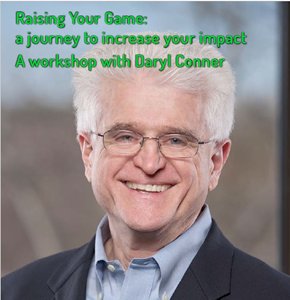As a seasoned change practitioner, do you have assignments where everything seems to go naturally, and you really have an impact? As opposed to those where your client keeps misunderstanding you and the change projects stalls…? Daryl Conner, a long-time change professional, wondered why some change practitioners get it done – and others – with the same toolkit and experience – don’t accomplish much.
He found an answer in our character and presence – WHO we are – that defines our unique contribution and whether or not we can impact this particular organization we work with. His workshop Raising Your Game is not about tools and techniques. It’s becoming aware that you are part of the intervention with clients. If you want to raise your game – there are three questions to consider…
We’ve come together in Berlin: a group of seasoned change facilitators, coaches, and leaders. We’ll spend two days with Daryl Conner on our professional development because no matter how personal we may get, the goal is to become more effective as professionals to serve and impact the organizations we work with.
Daryl Conner is concerned about our profession. “We’ve become technicians instead of artists. I want to facilitate change that matters.” Many consultants tick the boxes of a methodology and go through the motions without addressing the deep emotions and uncomfortable truths that sabotage change or even transformation.
Facilitating real change requires change facilitators to know who we are and how we come across with clients. It requires us to deal with any issues that hinder our facilitation (to deal with our fears, to grow the courage to speak the truth and be clear, to stop saving or pleasing the client so they can struggle and learn something, etc.). It requires us to find clients who will benefit from our unique contribution.
Daryl Conner summarizes: “Our true nature is synonymous with Who We Are. It has an epicenter called character that is conveyed to clients through the presence we cast. It’s by our character and presence that we invoke the kind of client impact we strive for.”
Play your own music
Metaphorically speaking, we each have our “musical style” comprised of the methodologies we use, along with our character and presence. We must know our profession and tools and techniques, but we must also know what our music is. It is important to focus your practice on clients who value your character & presence package – because you will be more impactful.That resonates with me. I did an assignment with a bank, a long time ago. We weren’t a good fit. I mastered my toolkit and knew what to do – but they were critical. I’m an expressive, extroverted person – and I felt I had to keep my voice down when working with them. They seemed to frown all the time – and I started to frown as well because I didn’t quite get what they wanted from me. We didn’t get into an effortless “flow”, we didn’t have “rapport” – a deep, comfortable understanding. They thought I was too loud, too bold, too creative in my proposals on how to communicate with employees – I got puzzled because that’s what they had hired me for and claimed that they wanted. “Yes, we want it, but not like this.” It was as if we were speaking different languages and it was tiring for both parties.
Daryl: “Don’t perform for people who don’t like it, don’t try to convince them, or play only requested songs. Don’t play so crowds will show up. Play for true fans who praise what you play, respect how you play and are impacted by your music. Don’t measure yourself by the number of people listening to your music, but by how many are touched by it – to think, feel, act differently.”
So, here are three questions: Who am I? How do I present that? Who would value that (which clients)?

Are you awake?
When do you spend time on exploring your character and presence nowadays? You’ve grown busy as an adult and no longer spend a whole afternoon with friends analyzing who you are. But it’s still relevant – because we keep changing. During this workshop, we introduce ourselves to one another – and learn how others perceive us. What do you leave out when you tell others about yourself? Dare you to include your vulnerability? How intentional is your introduction? Is it authentic? What is your presence conveying? Are you awake (aware) of what you perceive and what you project?
This is insightful. “There are three times to wake up: never, afterward or while it is happening,” says Daryl. “Don’t worry about it. As Eckhart Tolle says: Don’t ask, how long can I stay awake? Rather count how many times you woke up.” We are training our awareness – to see and sense what normally remains hidden.
Aspects of character
We choose a partner and explore further. My enthusiasm and extraversion may be obvious at first sight – but I also have a more hidden, introverted part who likes to work alone, in silence, and who reflects after attentive observation. I like to work fast, with rough lines – but some details matter to me. I seem easygoing, but I can become bossy when I need things my way. My humor and creativity sometimes give the impression you don’t have to take me seriously – but I’ve done my homework and know what I’m aiming for – and I take that very seriously. My pitfall can be to entertain the groups I’m working with because I talk so much – while it could be helpful to shut my mouth more often and let them struggle in the silence – so they can learn more…
Everyone has these aspects that are apparent or more hidden that are (un)comfortable and some that are helpful or hindering when you facilitate change projects.
What do you convey with clients? Confidence? Arrogance? Humility? Enthusiasm? Authenticity? I know my face is an open book. My extroversion stimulates me to be authentic – what you see is what you get, and people trust me easily. But not everyone likes what they get from me…
What helps or hinders your work?
Being authentic with the right team creates magic. When I work on an organizational culture, I explicitly address beliefs and behaviors, and I use my open-book-ness to mirror what is happening to serve the team. I can ask a group how they think I feel when they look at me. I can tell them what I think they feel – by looking at their energy level and nonverbal communication. I show my vulnerability to entice them to open up. Sometimes I hold back – I start slowly and carefully – to help the team relax and get comfortable in the workshop situation – before I expose my full range of creativity, directness, and slightly scary exercises. I may give unsolicited advice – or share uncomfortable observations or conclusions.
I remember a board of directors who said to me, leaning back on their chairs like after a heavy dinner, while a few were checking their phones: “Yeah, sure, let’s implement this plan.” I asked them to look around the board table and tell me what they saw. They shrugged. I asked them: “How would you assess the energy level? I don’t think this plan generates enough energy to get implemented.”
They got defensive, giving lengthy explanations – and I said: “It’s my job to tell you what I see. That’s why you hire me. I see a lack of energy, and I don’t believe this plan will make it.” They didn’t like my conclusion – and some were annoyed with me. Some started nodding – maybe something was still missing – and they shouldn’t make the decision yet…?
Magic
In my best sessions, I create so much rapport and trust that even silent team members share their insecurities with colleagues – and the group helps each other overcome them.
 A library team that entered the room reluctantly because they knew they had to work on daily feedback had changed deep beliefs by the end of the day – and exchanged to-the-point feedback that involved constructive criticism, and hugs, if necessary.
A library team that entered the room reluctantly because they knew they had to work on daily feedback had changed deep beliefs by the end of the day – and exchanged to-the-point feedback that involved constructive criticism, and hugs, if necessary.
In some projects people changed, tensions between managers and employees dissolved, decisions were made, and visions turned into actual reality – and one condition for this to happen was that I was my authentic professional self. I never saw these results when I was scared, insecure, uncomfortable, holding back or, on the other hand, dominating or pushing for outcomes or time.
It happened only when I was present in the moment with all of who I am, with tools and techniques if necessary – and when the team trusted me and together, we let things happen in an unbridled flow. We had first built trust and taken away the obstacles that block such a free flow of energy and information. An important part of that process is letting myself be seen – so others can decide whether they trust me or not – and whether I’m genuine. That may help them to open up to the process as well.
Your offer?
How do you behave when you are authentic? And is that always helpful? Do you sometimes misrepresent yourself? Maybe – when you fear the client won’t find you acceptable. I have sometimes acted more serious, dressed accordingly – and emphasized I’m a rational professional, instead of showing my intuitive side. I didn’t make jokes to help people relax – which I would normally do. But not with this client: I was hiding aspects of myself (not with the intention of letting them get comfortable first – as discussed before) but with the intention of being approved – so they would be content, and I’d be safe.
We’re all human – there are no supermen and women. Raising our game starts with waking up and noticing that we adjust our music to the (assumed) liking of this audience. To notice when you’re holding back and your client is not getting your unique contribution…. “What is it I have to offer if I’m not scared?” That’s a great question to raise your game.
Love your clients
It is important to love your clients – to have an impact. You build rapport, and once you have rapport, you can give any feedback. It’s tough love, sometimes. But you care enough, to be honest – and that will serve them. During the workshop, someone shared that he no longer loves his clients. He thinks: “O, here we go again.” He’s becoming cynical and experiences change fatigue. “Another change program that needs to be rolled out…” He feels trapped into a successful business with employees who depend on him – and he starts to feel like a fraud. He needs to reclaim his authenticity, to find his enthusiasm again – and decide whether he’s still in the right profession or situation. Answering that question is in everyone’s best interest.
Daryl: “It’s risky but extremely rewarding to claim your character, boldly express it through presence, and find clients who value who you are.”
Someone else has an “invoice-able me” and doesn’t like it anymore. “But my clients are happy.” Yet, how can you be true to others if you’re not true to yourself?
“The invoice for living an authentic life and claiming your sovereignty is daunting. It’s complicated, arduous and risky. Living an inauthentic life has an invoice as well. It may bring in money but also despair. You’re paying with your life”, says Daryl.
While we do several exercises with partners, alone or in the group – we dive deeper into our characters and presence – and what we’re missing or enjoying with clients – and whether we should change clients or the way we work or the kind of work we do.
Daryl: “If you’re not firing a client now and then, you’re not doing your work. You can’t be the best fit with all of them all the time.”
What clients want
 During our exploration, we stumble upon practical issues. Clients ask for tools, or demand deliverables, milestones. They rely on planning and control – they want to know the budget and planning in advance. The paradox is this: real change often emerges, it’s an unpredictable process that you can’t set in stone up front. But clients don’t like to buy processes, they buy solutions and outcomes.
During our exploration, we stumble upon practical issues. Clients ask for tools, or demand deliverables, milestones. They rely on planning and control – they want to know the budget and planning in advance. The paradox is this: real change often emerges, it’s an unpredictable process that you can’t set in stone up front. But clients don’t like to buy processes, they buy solutions and outcomes.
When I’m facilitating change and working with culture – I can’t guarantee 75% results by February 5. I can only do culture workshops with ten teams before that date – but I have no idea what the outcome will be… I love that journey. The client organization often prefers a fixed destination. My challenge is to engage with client organizations that are open to travel with me – so we can explore what emerges in the moment and create real change. I settle for giving them a rough planning of activities and tell them that we will work in that direction – and see what the outcomes will be. If they trust me, we can embark on the journey.
During the intake, clients might say that they have only 30 minutes per week to work with you, even though the change is extremely important. It’s important to explain that it will be a lot of work and might be hard, so what do they want? Daryl: “When you see a doctor you don’t ask for the 30-minute operation – you trust their expertise and probably know that your operation will take 3 hours. You don’t ask for aspirin when you have cancer. Don’t rescue, don’t compromise. Simply present the choices.” It’s our professional responsibility to be clear about what it takes and to present the client with that choice. Do you or do you not want this change with my facilitation?
For instance, working with my change-circle-approach takes a full day with no more than ten people in a room, for each team or group. Only ten people? Can we do it in groups of 20 people to save time and money? Should we include everyone or can we leave out the lower-ranked employees? Over the years, I have learned not to compromise these conditions – or we won’t achieve culture change. But it can be tough. Things don’t always work out well, even if you are clear up front. I checked whether a CEO would be open for change – he assured me he was – I told that uncomfortable things could come up during the workshop – he said that was fine. Yet, he didn’t like it when that happened – and he withdrew – stalling the change process and persuading the others to stop cooperating as well… I can’t predict everything, but I could have given him more specific examples of painful outcomes so he could have been “prepared for anything”. Maybe that would have helped. Maybe not.
As Daryl recognized: “The client’s system is never perfectly right. So I look for a predisposition in the system of what might work – are they ready for it?” He sees a change process develop in four stages, starting with uniformed optimism during the start (“We want this”) to informed pessimism (“This is tough”) to hopeful realism (“Let’s commit”) and informed optimism (“This can work if we see it through”). A helpful idea is to re-contract during the process, so you can fire the client if they don’t see it through.
More Being than Doing
Daryl emphasizes: “You serve the sponsor who hired you. You’ll help them fight their battles if necessary, but you don’t fight their battles for them.” Bad sponsorship is no sponsorship. The sponsor gives you air cover – and you may be the ground forces in the field. The system is likely to fight back when you try to change it. The level of sponsorship you need depends on what you’re hired to do in the organization. In my culture work, my sponsor is either the CEO and the top executive team or, sometimes, HR – but only if they collaborate closely with the top executives. I’ve learned from my mistakes, so nowadays I check first whether the CEO is trying to “outsource culture change” to me – because that’s an assignment I can’t do. I can’t change the others. They, including the CEO, have to do the work!
Last but not least, Daryl stresses that change practitioners:
* demonstrate courage and tenacity to relay their observations, insights, recommendations – and this authenticity is an important part of their value proposition
* work in environments where they get political air cover and don’t waste their talents working with people who don’t want their capabilities
* engage in careful due diligence
If you don’t do this, you can’t strengthen what you do with who you are.
I like Daryl’s lessons learned as they align with mine: Help clients be honest and move beyond “role play”. Don’t do their work – they’re entitled to learn from their own struggles. I hold the space with attention – while they raise their awareness and decide why what and how to change.
During this workshop, the participants realize how much change facilitation (and leadership) comes down to holding the space for others. Creating a space in which they can learn and change – in which the process can unfold. It’s more about being than doing. It’s more about who we are, with our awareness, than which tools we use.
* Who am I?
* How do I project that?
* Who would value that (which clients)?
Marcella Bremer is an author and change consultant who works with culture. She co-founded this blog and OCAI online<
Daryl Conner is Chairman of Conner Partners, an Atlanta-based consulting firm (www.connerpartners.com). For the last four decades, he has served as a change-related advisor and mentor to senior executives around the globe.
Daryl Conner’s webinar: “Character and Presence” is available in the members area.

2 Responses
Good work Marcella… a super acknowledgement of Change starts with Me… as the key to successful interventions. Our world of work is a real challenge and we do need to learn from what works and honestly reflect on what doesn’t before we do something different.
In our work we know we need a ‘powerful voice’ describing the direction and action plan of the change and we know that the fast track to the ‘ flow ‘ is the bumpy ride as the change waves build up and colleagues in the change start to describe Change starts with Me.
The credibility of the interventions and the Upskill needed to deliver transformational change go hand in hand and Consultant credibility and mutual Trust in the people and the process almost needs to front end the successful project.
Another challenge for us is the old ‘T group’ message, high air time equals low trust, unfair but true,engagement through experiential learning creates ‘silence space’ so that leaders towards the new order can; observe, reflect and form new opinions on how we get there.
Twenty colleagues hit Uh-Oh within the first two hours on a workshop, former Army Major who had directed the team in the wrong direction says ‘ I will never trust New Era again ‘ three days later he did !!
Thanks for sharing, Clive. Yes, change starts with Me, and an authentic Me… Trust flows from there.